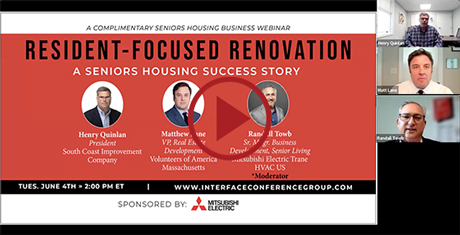There are many ways to renovate an existing seniors housing property, but one of the most complicated may be expanding and renovating a community while it’s still occupied.
That was the challenge faced by Volunteers of America (VoA) Massachusetts when it wanted to add a third floor to its Concord Park Senior Living community in Concord, Massachusetts, while also renovating all existing units and common areas and completely replacing the heating and cooling system.
Representatives from VoA were joined by several project partners on June 4 for a webinar titled “Resident-Focused Renovation: A Seniors Housing Success Story” that recapped how the successful renovation took place. Speakers included Henry Quinlan with contractor South Coast Improvement Co.; Matthew Lane from Volunteers of America Massachusetts; and Randall Towb of Mitsubishi Electric Trane HVAC US, which installed the new heating and cooling system.
Mitsubishi Electric Trane HVAC US sponsored the Seniors Housing Business webinar.
The project began in 2019 and involved adding 21 new units by building a 25,000-square-foot third floor onto the existing 60,000-square-foot community, while also renovating existing units and common areas. The ambitious project was carried out “all while residents remained living at the community,” noted Towb.
The budget was $17 million and the schedule called for 18 months of construction.
Quinlan said that the project was a success because the contractors, designers and owners all came to the table together in the planning phases.
“If all three of those players are aligned in the goal for a successful project, the project will be a success,” he said. “We’re dealing with people’s homes. We’re affecting people’s work lives. And it’s a revenue-generating entity for the owner. To navigate those waters, you need cooperation from both the owner and the design team.”
“This is not a situation where you design it first and put it out to bid,” concluded Quinlan. “That’s a recipe for disaster.”
The new HVAC system that was installed was a variable refrigerant flow (VRF) system, which enables the residents to individually control the temperature of their rooms rather than having a building-wide temperature. The system is also much smaller than the previous one (an “eyesore,” according to Quinlan), opening up more parking at the community.
The downside was that it meant unit renovations were not simply a coat of paint and some new furniture. New ductwork had to be installed, meaning residents had to be temporarily moved out of their units as each was worked on.
VoA managed this by using the new expansion as “hotel rooms” to temporarily move residents while each unit was being renovated.
“If we didn’t have that then this project would probably still be going,” said Lane.
The complications didn’t end there, though. Less than a year into the project, the COVID-19 pandemic struck. “That created a whole new set of challenges,” said Quinlan.
Workers had to be screened for possible infection, and direct contact between workers and residents had to be minimized.
Meanwhile, VoA still needed to market vacant units for rent as a reality of continuing to bring in revenue at the established community.
“It’s hard to do when you have people walking around with hard hats, but we made it work. There was a real team effort there.”
While there were certainly hiccups in the project, Quinlan said that the planning, cooperation and communication between the involved parties are why the project ended as a success for everyone.
“We’re not delivering pizzas. It’s not perfect. There are going to be some disruptions. But if you have great communication and a reasonable owner and great design team, you can overcome anything.”
Lane said the community has been near full occupancy since the project was completed. “If we didn’t have this beautiful product to show people, we’d be in a different position. We do have competition in the area.”
To view the full webinar, click here.
— Jeff Shaw

